the sonepat-jind pioneers india’s hydrogen train story
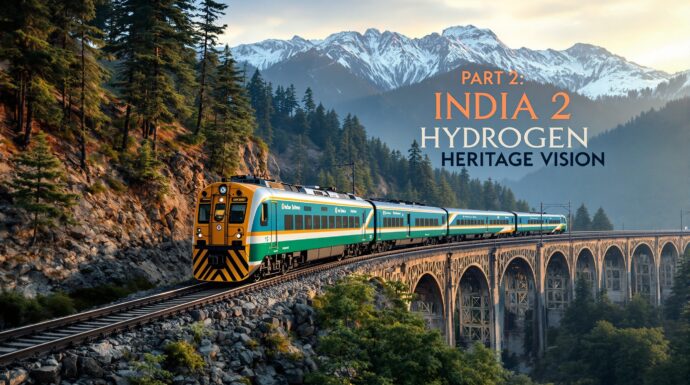
In Part 1, we explored how Germany pioneered the hydrogen train and how this technology spread globally. Now, let’s bring the story home to India, where a quiet revolution is underway in the heart of Haryana and the mountains of Himachal and West Bengal.
India is on the cusp of becoming the fifth country globally to operate hydrogen-powered trains. But India isn’t simply copying what others have done. With a unique retrofit approach for cost-effectiveness and an ambitious “Hydrogen for Heritage” vision targeting 35 trains on UNESCO World Heritage mountain railways, Indian Railways is charting its own distinctive path.
Let’s explore what makes India’s hydrogen railway journey special and why heritage routes might be the perfect launchpad for this revolutionary technology.
India’s First: The Sonepat-Jind Hydrogen Train Pioneer
While Germany bought brand-new purpose-built hydrogen trains from Alstom, India has taken a different, characteristically pragmatic approach: retrofitting existing Diesel Electric Multiple Units (DEMUs) with hydrogen fuel cell technology.
This indigenous innovation, developed by Indian Railways in collaboration with the Research, Design & Standards Organisation (RDSO), showcases both engineering ingenuity and cost-consciousness.
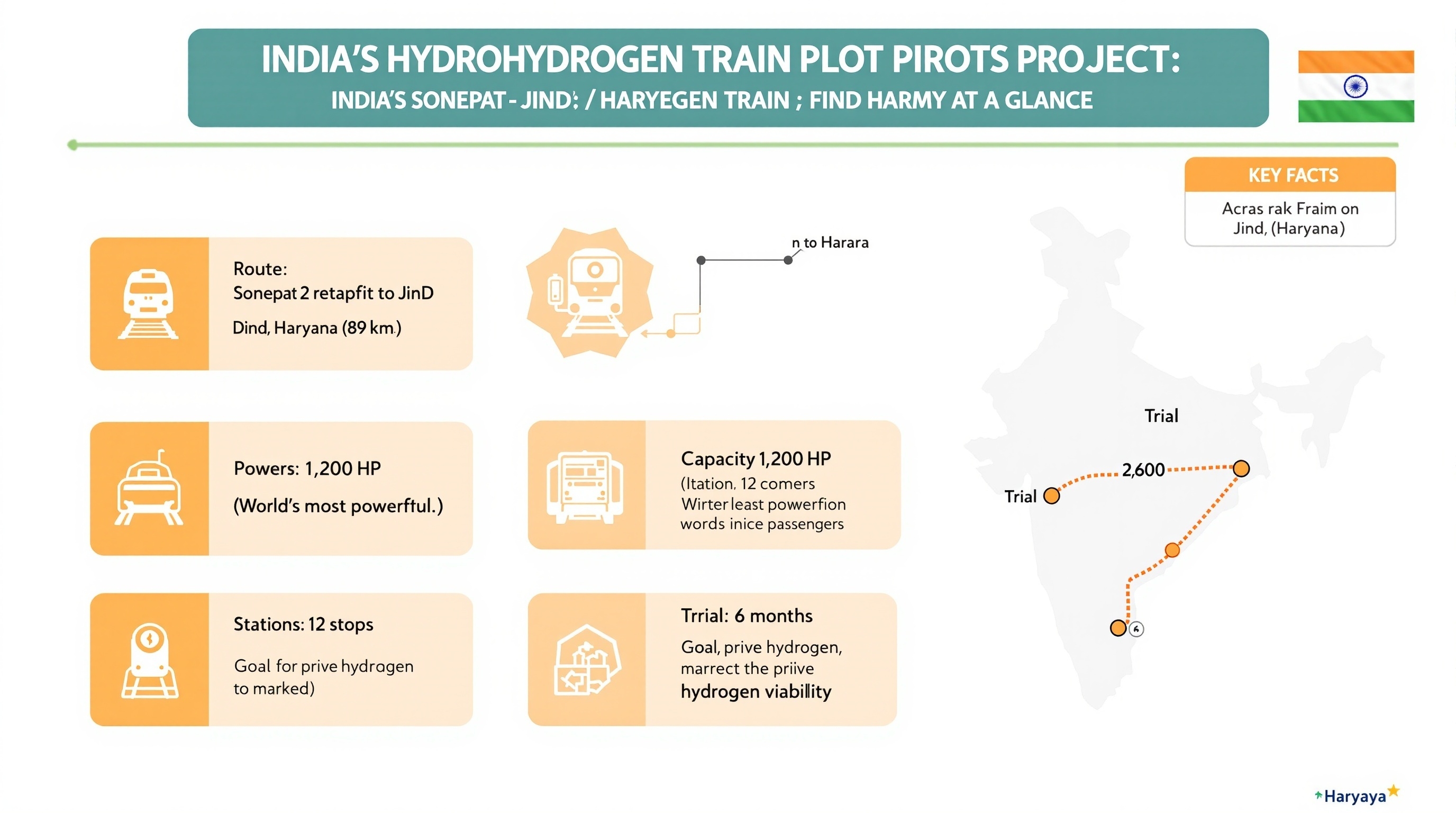
The Pilot Project: By the Numbers
Route: Sonepat to Jind Section, Northern Railway, Haryana
Distance: 89 kilometres
Rolling Stock: 2 Diesel Power Cars (DPCs) converted to hydrogen
Power Output: 1,200 horsepower (potentially the world’s most powerful hydrogen train)
Passenger Capacity: Up to 2,600 passengers
Stations Served: 12 stations along the route
Trial Duration: 6 months of comprehensive testing
Approach: Cost-effective retrofitting vs expensive new purchases
Railway Minister Ashwini Vaishnaw recently unveiled glimpses of the hydrogen train, calling it “a transformational moment in Indian Railways’ journey toward sustainability”, as reported by Times of India.
Why Sonepat-Jind Was Chosen for Hydrogen Train Heritage Route
This specific 89-km stretch wasn’t selected randomly. It offers ideal conditions for hydrogen technology testing:
✅ Non-Electrified Route – Perfect testing ground for comparing hydrogen against diesel
✅ Moderate Traffic Density – Allows real-world validation without disrupting major corridors
✅ Proximity to Delhi NCR – Easy access for engineers, monitoring, and technical support
✅ State Government Support – Haryana backing for green transportation initiatives
✅ Flat Terrain – Initial testing on easier topography before mountain deployment
✅ Mix of Urban and Rural – Tests performance across diverse operational environments
Under the Hood: What Goes Into India’s Hydrogen Train?
India’s retrofit approach involves sophisticated integration of hydrogen systems with existing train infrastructure:
Onboard Systems (Train-Mounted):
Fuel Cell Assembly:
The fuel cell assembly converts hydrogen into electricity to power the vehicle’s traction system. It is designed to integrate seamlessly with existing electrical systems, ensuring efficient performance and reliability.
Hydrogen Storage Cylinders:
High-pressure storage cylinders, typically rated between 350 to 700 bar, are strategically mounted on the vehicle. These tanks provide adequate hydrogen capacity to support a complete round-trip operation without refuelling interruptions.
Li-Ion Battery Pack:
The lithium-ion battery pack serves as an auxiliary energy storage system. It delivers additional power during acceleration and captures energy through regenerative braking, enhancing overall energy efficiency and performance.
Power Converters & Inverters:
The electrical system includes DC-to-AC converters with boost functions, traction converters for precise motor speed and torque control, and auxiliary converters that power systems like HVAC, lighting, and automatic doors.
Control & Monitoring Systems:
Advanced electronic control units manage the operation of the fuel cell, regulate battery charging and discharging, and ensure safety through real-time diagnostics and automated protection protocols.
Ground Infrastructure (Station-Based):
The hydrogen ecosystem includes a filling station at Sonepat with a stationary storage facility and high-flow refuelling dispensers. The setup features safety interlocks, leak detection mechanisms, and automated filling systems for secure and efficient operations.
Guaranteed Hydrogen Supply:
A contracted hydrogen supply ensures uninterrupted availability throughout the six-month trial period. This phase will also test various sourcing and logistics models to determine the most efficient and sustainable supply chain.
Safety Systems:
Comprehensive safety measures are in place, including hydrogen detection sensors, emergency shutdown mechanisms, and fire suppression systems. Additionally, trained emergency response teams are stationed to handle any contingencies.
The beauty of this retrofit strategy is cost-effectiveness: adapting existing rolling stock rather than importing expensive German or Japanese trains keeps the pilot affordable while thoroughly proving the technology for Indian conditions.
Hydrogen for Heritage: The Vision That Sets India Apart
Here’s where India’s hydrogen railway story transforms from interesting to inspired. Beyond the Sonepat-Jind pilot, Indian Railways has announced plans to deploy 35 hydrogen-powered trains specifically on narrow-gauge heritage routes.
This “Hydrogen for Heritage” initiative represents a globally unique approach targeting some of India’s most beloved and UNESCO-recognised railway journeys.
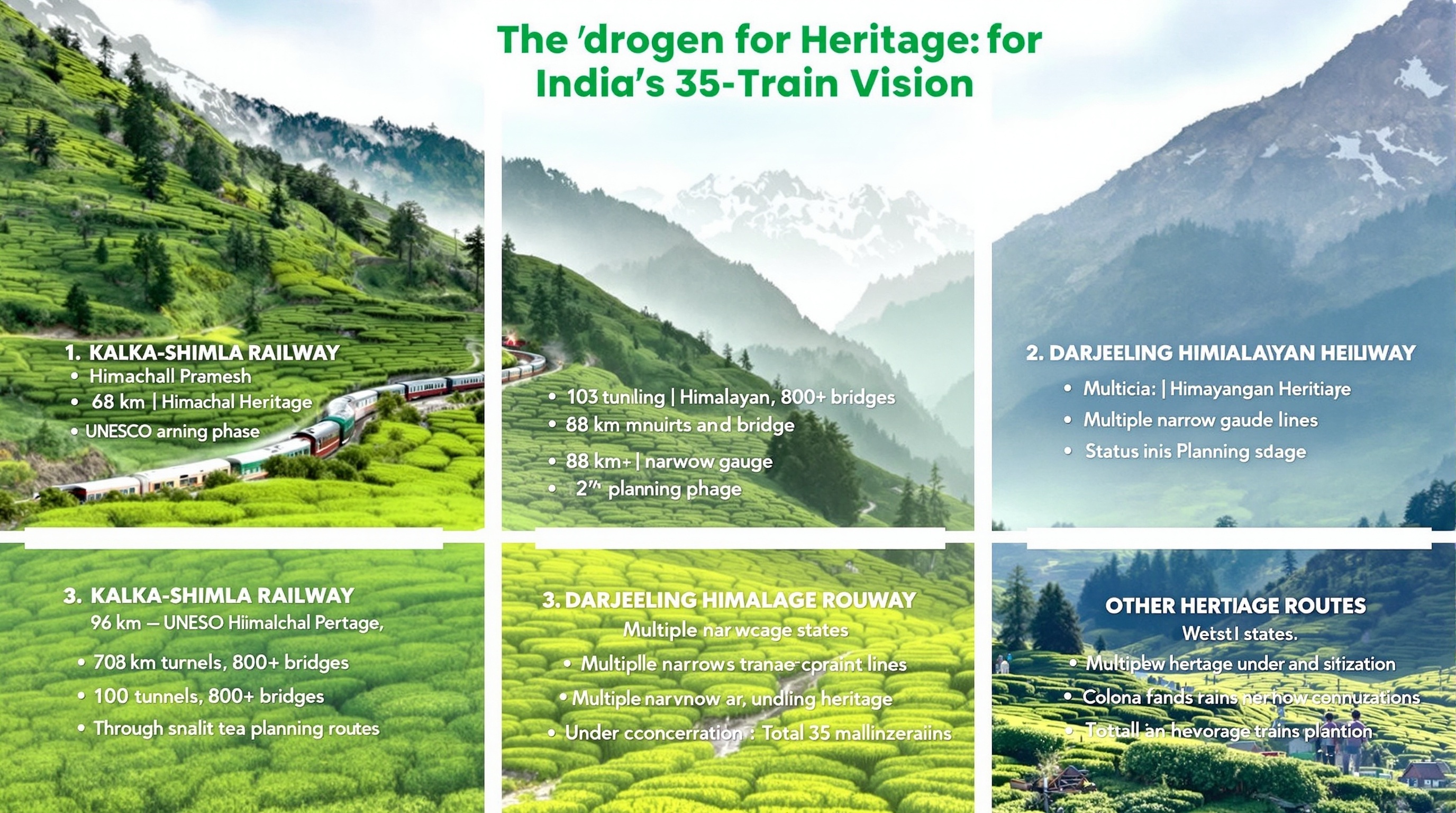
🏔️ The Kalka-Shimla Railway: A UNESCO Jewel
Location: Himachal Pradesh, Northern India
Length: 96 kilometres
Gauge: 2 ft 6 in (762 mm) narrow gauge
Status: UNESCO World Heritage Site since 2008
Engineering Marvel:
- 103 tunnels (102 currently operational) aggregating 5 miles
- Over 800 bridges spanning valleys and gorges
- Dramatic elevation gain from Kalka (656m) to Shimla (2,076m)
- 919 curves navigating the mountainous terrain
- Construction period: 1898-1903 (completed in just 5 years)
The Guinness Book of Rail Facts & Feats records the Kalka-Shimla Railway as “the greatest narrow gauge engineering feat in India.”
Currently, diesel locomotives emit fumes that mar the pristine mountain environment and contradict the UNESCO World Heritage Site’s conservation principles. Hydrogen trains would transform this iconic experience entirely, leaving only water vapour as the “toy train” climbs through deodar pine forests.
Himachal Pradesh Chief Minister Sukhvinder Singh Sukhu has been actively advocating for this transition, urging the Centre to prioritise green hydrogen for this heritage route, as reported in The Hindu.
“Running trains on green hydrogen would preserve the heritage site’s environmental integrity while positioning India as a global leader in sustainable tourism.”
The Darjeeling Himalayan Railway: The “Toy Train”
The DHR represents more than transportation; it’s living history. Converting it to hydrogen operation would ensure this 19th-century engineering wonder operates with 21st-century environmental responsibility.
Additional Heritage Routes Under Consideration
Nilgiri Mountain Railway (Tamil Nadu) – 46 km through Nilgiri Hills
Matheran Hill Railway (Maharashtra) – 20 km to the hill station
Other narrow gauge lines across Rajasthan, Gujarat, and Northeast India
Total Planned Deployment: 35 hydrogen trains across the heritage network
Why Hydrogen is PERFECT for Heritage Railways
You might wonder: why not just electrify these heritage routes like mainline tracks? The answer reveals why hydrogen represents a uniquely elegant solution for heritage railways:
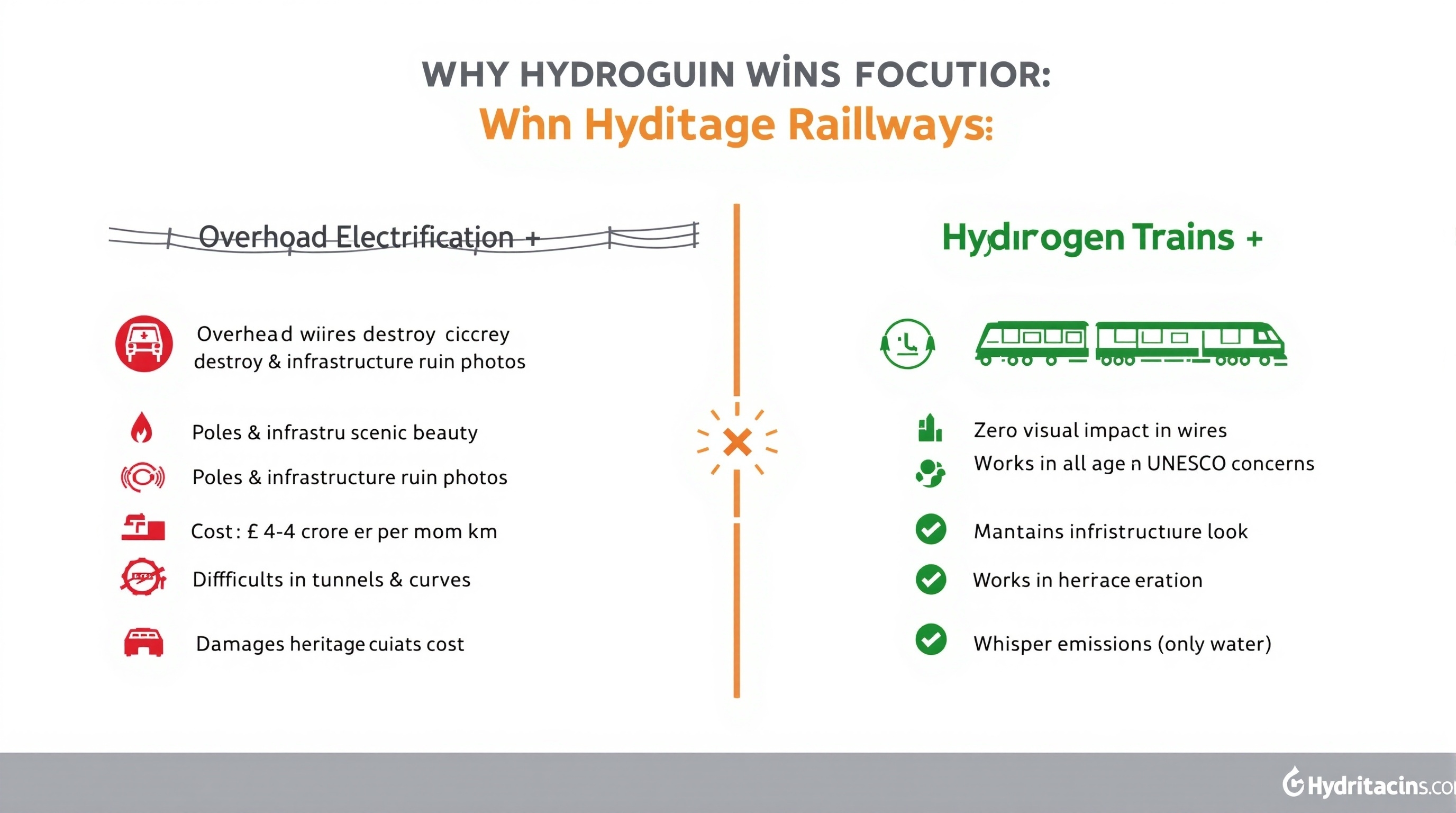
The Compelling Case:
❌ Why Overhead Electrification Doesn’t Work:
Visual Pollution – Overhead catenary wires and support poles would destroy the very scenic beauty that makes these routes UNESCO World Heritage Sites
Tourist Experience – Every photograph would feature unsightly electrical infrastructure
Astronomical Cost – ₹4-5 crore per kilometer for narrow gauge = ₹400+ crore for Kalka-Shimla alone
Engineering Nightmares – 103 tunnels, tight curves, steep gradients make overhead electrification extremely challenging
Heritage Destruction – Modern electrical infrastructure would irreversibly compromise historical character
UNESCO Issues – Likely objections from World Heritage Site conservation authorities
✅ Why Hydrogen Is The Answer:
Zero Visual Impact – No overhead wires, no poles, no visual intrusion whatsoever
Pristine Photography – Tourists capture unspoiled mountain vistas
Cost Savings – Avoids ₹400+ crore electrification cost
Engineering Simplicity – Works perfectly in tunnels, on curves, at any gradient
Heritage Preservation – Maintains authentic colonial-era aesthetics
UNESCO Compliance – Aligns with World Heritage Site conservation principles
Zero Emissions – Only water vapor, perfect for ecologically sensitive mountain ecosystems
Quiet Operation – Passengers hear nature, not diesel engines
Imagine riding the Kalka-Shimla toy train through mist-shrouded pine forests, with nothing but the quiet hum of electric motors and water vapor trailing behind. No diesel fumes. No overhead wires. Just pure, authentic heritage railway experience powered by the cleanest fuel on Earth.
India’s Net Zero Railway Vision: The Strategic Context
The hydrogen train initiative doesn’t exist in isolation. It’s a cornerstone of Indian Railways’ commitment to become a Net Zero emission network by 2030 an integral part of India’s broader climate action strategy.
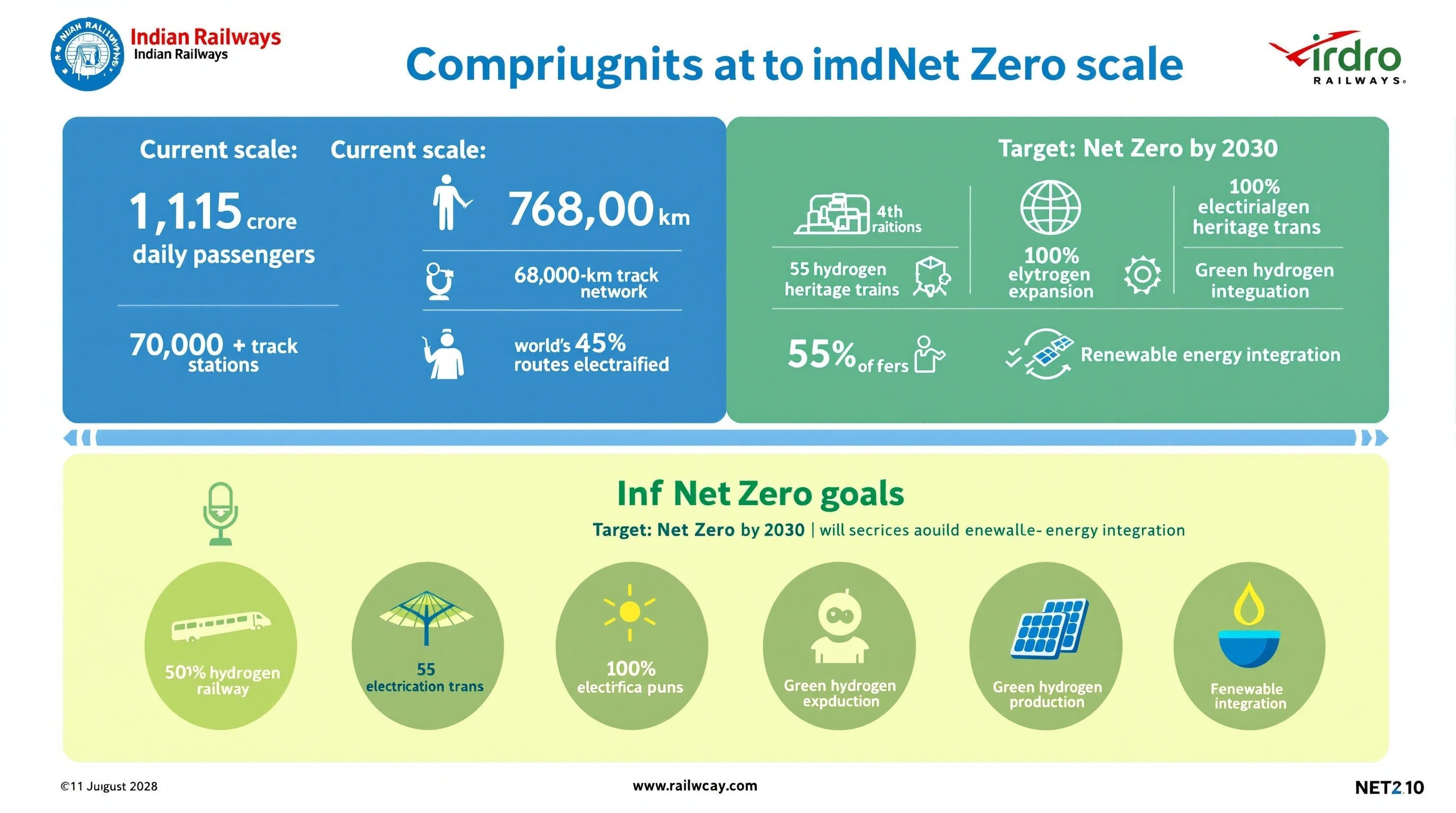
The Scale of the Opportunity:
Current Network Size:
- 11.5 million passengers daily across the network
- 7,000+ railway stations from metros to remote villages
- 68,000+ kilometres of track crisscrossing the nation
- World’s 4th largest railway network by size
- 45% of routes are still non-electrified, primarily branch lines and heritage routes
Why This Matters for Climate Action:
Even partially transitioning diesel locomotives to hydrogen could deliver transformational environmental benefits:
The introduction of hydrogen-powered systems in one of Asia’s largest railway networks will lead to massive reductions in carbon emissions, marking a significant step toward India’s clean energy transition. Improved urban air quality will follow, especially in densely populated cities, tourist destinations, and smaller towns, contributing to healthier living environments. This shift also enhances energy security by reducing India’s heavy reliance on imported petroleum—currently around 80% of its consumption.
Beyond environmental benefits, the initiative strengthens technology leadership, positioning India as a pioneer in green rail innovation and sustainable transport solutions. It will also stimulate job creation across the hydrogen value chain, from production and maintenance to operations and logistics. In the long run, the adoption of green hydrogen promises substantial cost savings, as scaling up domestic production will make fuel more affordable and economically viable.
Union Minister Manohar Lal emphasised at UMI 2025 that with 1,100 km of operational metro networks, India is now the world’s third-largest metro network. The hydrogen train initiative extends this green mobility momentum to intercity and heritage routes, completing the sustainable transportation ecosystem.
India’s Green Hydrogen Mission: Powering the Railway Revolution
For hydrogen trains to truly deliver on environmental promises, they need green hydrogen produced from renewable energy. India is making massive investments to ensure this becomes reality:
National Green Hydrogen Mission Highlights:
India has set an ambitious production target of 5 million tonnes of green hydrogen annually by 2030, marking a transformative leap toward clean energy independence. To support this, the country plans to establish 125 GW of renewable energy capacity exclusively dedicated to hydrogen production, ensuring a sustainable and carbon-free supply chain.
The government has allocated ₹19,744 crore under the National Green Hydrogen Mission to drive implementation, innovation, and infrastructure development across sectors. With a clear global ambition, India aims to position itself as a leading hub and exporter of green hydrogen, strengthening its role in the international clean energy market. The strategy also includes dedicated hydrogen production for the railways, paving the way for a greener, self-reliant, and future-ready transport ecosystem.
Hydrogen Sources for Indian Railways:
Solar-Powered Electrolysis
Massive solar farms across Rajasthan, Gujarat, and Karnataka will serve as the backbone of hydrogen generation through solar-powered electrolysis. Production will primarily occur during the day, supported by energy storage systems to ensure round-the-clock availability. Once infrastructure is established, operational costs remain low, making this model highly cost-effective. This approach is particularly suited for the western and southern railway zones, where solar potential is among the highest in the country.
Hydro-Powered Electrolysis
Hydropower-driven electrolysis will utilise the vast potential of Himalayan hydroelectric projects, especially near mountain and heritage railway routes. These regions already generate substantial renewable electricity, which can be efficiently harnessed for local hydrogen production. Localised generation reduces transportation costs and ensures a steady, sustainable fuel supply for high-altitude and remote rail operations.
Wind-Powered Electrolysis
Coastal regions such as Tamil Nadu, Gujarat, and Andhra Pradesh offer ideal conditions for wind-powered hydrogen production. Wind energy complements solar generation, often producing power during nighttime, allowing for a balanced and continuous hydrogen supply. Leveraging existing wind infrastructure makes this option both practical and scalable, especially for the eastern and southern railway corridors.
Biomass & Waste-to-Hydrogen
Agricultural residues and organic waste can be converted into hydrogen, turning a major environmental challenge into an opportunity. This biomass and waste-to-hydrogen pathway not only supports waste management but also provides a clean energy source for rural and regional railway networks. Additionally, it opens up new income avenues for farmers and rural communities, integrating sustainability with local economic development.
The vision is localised hydrogen production near major railway corridors, reducing transportation costs while creating regional green energy hubs that serve multiple sectors.
That covers India’s hydrogen train pilot and heritage vision! In Part 3, we’ll dive deep into the economics, challenges, timeline, and what this means for you as a traveller. Will hydrogen trains pay off financially? When can you actually ride one? What hurdles lie ahead? Stay tuned for the final instalment
This is Part 2 of a three-part series. Read: Part 1: The Global Hydrogen Revolution | Part 3: Economics, Challenge & Timeline.
This article is based on insights shared at the 18th Urban Mobility India Conference & Exhibition, held in Gurugram. For more stories on sustainable urban mobility and policy analysis, stay tuned to Urban Voices.
